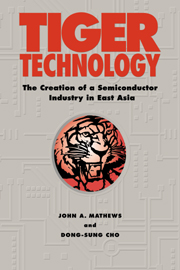Book contents
- Frontmatter
- Contents
- List of Figures
- List of Tables
- Preface
- Abbreviations
- Introduction
- Part I The ‘Real’ East Asian Miracle
- Part II National Institutional Pathways
- 3 The Tangun Boom and the Chaebol: How Korea Did it
- 4 A Cat Can Look at a King: How Taiwan Did it
- 5 Jack and the Beanstalk: How Singapore and Malaysia are Doing it
- Part III The Technology Leverage Strategy
- Appendix I Exchange Rates: 1975–97
- Appendix II Chronolog
- Glossary
- Bibliography
- Index
4 - A Cat Can Look at a King: How Taiwan Did it
Published online by Cambridge University Press: 09 October 2009
- Frontmatter
- Contents
- List of Figures
- List of Tables
- Preface
- Abbreviations
- Introduction
- Part I The ‘Real’ East Asian Miracle
- Part II National Institutional Pathways
- 3 The Tangun Boom and the Chaebol: How Korea Did it
- 4 A Cat Can Look at a King: How Taiwan Did it
- 5 Jack and the Beanstalk: How Singapore and Malaysia are Doing it
- Part III The Technology Leverage Strategy
- Appendix I Exchange Rates: 1975–97
- Appendix II Chronolog
- Glossary
- Bibliography
- Index
Summary
In the mid-1980s, when Japan and the US were locked in their battle for world supremacy in semiconductors, and Korean firms like Samsung were making their first forays into the DRAM sector, the Taiwanese semiconductor industry did not look much like a threat. There were several foreign-owned and domestic IC packaging and testing companies operating at the ‘back end’ of the semiconductor value chain and a few IC design houses that took advantage of the favourable conditions at the Hsinchu Science-based Industry Park. But there were only two IC fabrication plants on the island – one operated by the public-sector research institute, ERSO, and one operated by the ERSO spin-off company, UMC. By international standards the latter was a very small company, and its output was limited to simple LSI chips for consumer product applications such as toys, watches and greeting cards. Plans to produce DRAMs or other complex IC products like microprocessors seemed a long way off.
Only ten years later, the Taiwan semiconductor industry had risen to be the fourth largest in the world, and its firms were holding their own in international competition, and entering strategic alliances with the cream of the Japanese, European and American industry players. Like the cat in the fairy story, Taiwan had shown that it could look the industry leaders in the face. Clearly there was a lot more happening in Taiwan in the mid-1980s than was evident to the outside observer.
- Type
- Chapter
- Information
- Tiger TechnologyThe Creation of a Semiconductor Industry in East Asia, pp. 157 - 202Publisher: Cambridge University PressPrint publication year: 2000



